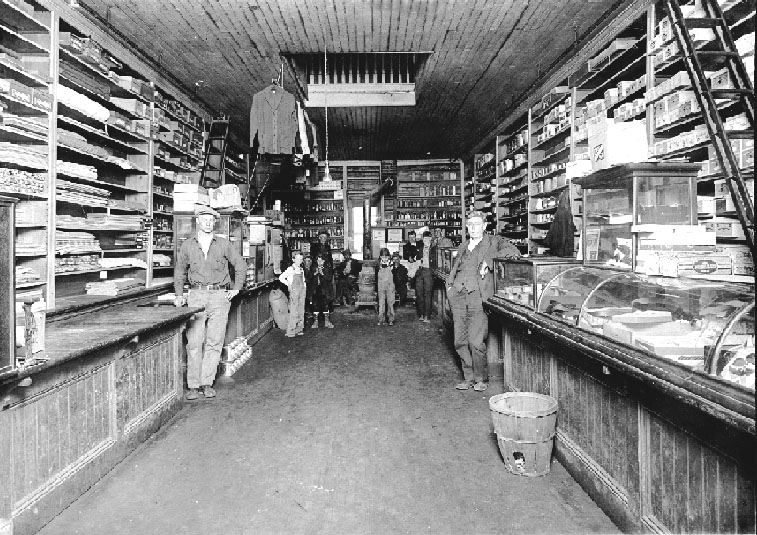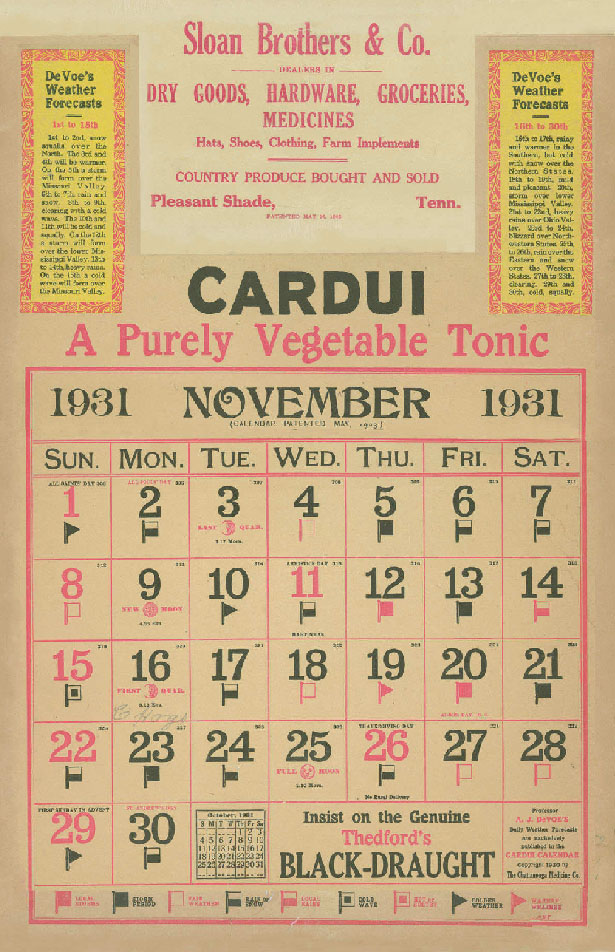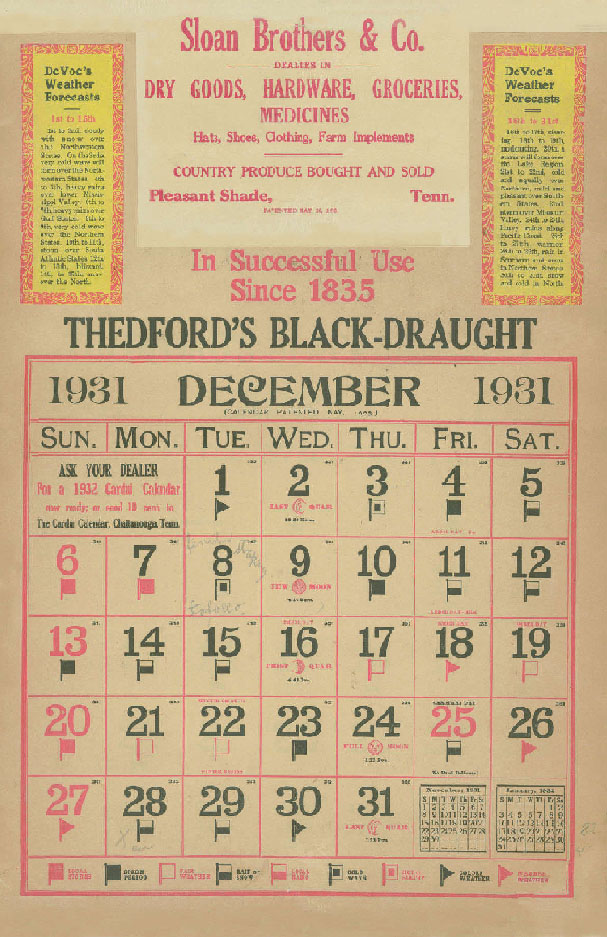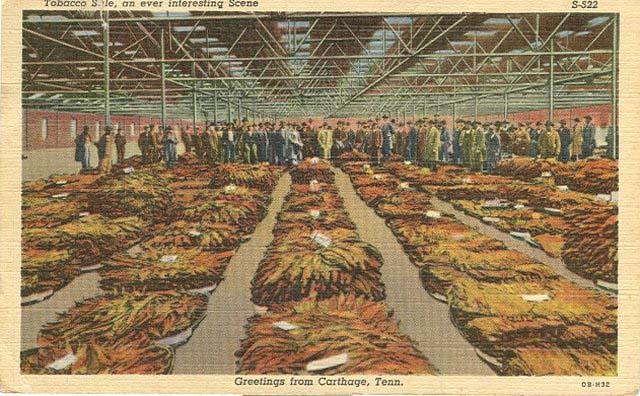
Old Sloan Bros. Store At Pleasant Shade
Click On Picture to see the full size image file. This is a large file be patient!
The old Sloan Brothers Store at Pleasant Shade is shown in about 1932. The operator
and part owner of the store was Mann Sloan shown in the suit and vest on the right.
Elisha E. "Mann" Slaon was the son of Elisha Brockett and Elizabeth Goad Sloan
Photos of this family and write up can be seen on this website:
Across from him is John Cornwell who was a store employee. None of the other eleven
people are known except Oak Dickerson (my uncle). He is the man in the back in the
dark coat (no hat) to the right of the stove. With all those bottles in the back,
one might mistake the back of the store for a saloon but many of the bottles really
contained prescription medicines to be filled by the druggist, Clayton Hesson. He
was Mann's brother-in-law. After Mann's death in 1933, Oval Sloan, Mann's nephew,
bought and operated the store, serving also as the druggist.
(Oval is pictured in the 1929/30 Pleasant Shade School pictures when he was a teacher.)
Clayton Hesson's certificates announcing his abilities as an apothecary are displayed at
his workstation. Dr. John J. Beasley, the local medical doctor whose office was located
near the store wrote many of the prescriptions for these medicines.
The stack of gallon cans on the floor behind John Cornwell may be molasses. Someone missed
the trash can (prior use was an apple basket) and left their cigar butts on the floor in front of
Mann Sloan. The loaves of bread atop the showcase on the right are the "Butter Flake" brand.
Lots of shoeboxes and bolts of cloth may be seen on the shelves along with coffee pots, pans,
buckets, kerosene lanterns, etc. Access to the higher shelves was provided by rolling ladders
attached to ceiling rails that were built into both sides of the store behind the counters. At the
extreme left of the picture on the counter is the roll of wrapping paper on the cutter device
ready for making a neat package of the sewing material or other items that may be sold.
Electrification had recently come to "downtown" Pleasant Shade and this part of the store
was illuminated by what appears to be one 200W bulb near the center of the store and one
light over the druggist's section. The out-lying areas around Pleasant Shade did not get
electricity until about 1946. Notice the clothing hanging from the ceiling. Further inspection
shows that the clothes were hanging on a rod that was attached to cords and pulleys allowing
them to be lowered to the floor level. The cutout in the ceiling was provided to allow hoisting
large articles of goods to the second level of the store.
This store had very much the same appearance twenty-five years later. Here, many high school
students including myself would wait at this store (and challenge the sanity of the operators)
while the school buses gathered other children from the hills and hollows before continuing
the circuit to Carthage, ten miles south.
Sloan Brothers Store was the largest of the three or four general stores in Pleasant
Shade during the 1940's, 50's and 60's. It was one of the landmarks of the community
but unfortunately it burned in the late 1970's or early 80's.

Sloan Bros. 1931 November Calendar
Click On Picture to see the full size image file. This is a large file be patient!
See write up below!

Sloan Bros. 1931 December Calendar
Click On Picture to see the full size image file. This is a large file be patient!
Beth Sloan Wilburn provided these calendar pictures and family information. She found the
old calendar in some of her late mother's (Imogene Williams Sloan) old papers and belongings.
Archie Sloan, grandfather of Beth Sloan Wilburn, probably owned this 1931 Sloan Brothers Store
calendar, showing the months of November and December. In 1931, Elisha (Mann) Sloan, shown in
the above picture, was the operator and part owner of the store. The other owners were Mrs. J.
J.(Edith Sloan) Beasley, wife of the resident doctor and William (Billie) Sloan, siblings of
Mann. A picture of these individuals and their other family members are on this website.
On the November calendar, day 16, "C hogs" was penciled-in, perhaps making reference to hogs
being slaughtered on that day. (My grandfather, John Dickerson, always tried to kill his hogs
on Thanksgiving Day.)
Hog killing day was a pretty exciting time for young boys and perhaps even for grown
people at Pleasant Shade. First of all there was the anticipation of dining on the great
tasting fresh pork that would soon be available and then there was the excitement of
watching the various steps in carrying out a hog killing. Examples of the mouth-watering
pork soon to be prepared for the table included tenderloin, sausages, brains and eggs
(I didn't go for that too much), backbone, ribs, liver, feet, heart, cracklings and
other parts of the hog. A typical family might slaughter three or four 300-pound hogs
that would provide them, in addition to the above-mentioned parts, with shoulder, ham
and bacon (side meat) lasting until about the next hog killing time. These cuts were
placed in layers of salt in the "meat box" to preserve them and later hung in the
smokehouse where they were smoked. I think the smoke added flavor to the meat and
also helped to keep the "skippers" out. (Skippers are small insects that hop and
fly with jerky motions. If they infested a ham it would be ruined. They are kin to
butterflies.) Sometimes multiple families would combine their efforts and kill their
hogs together. The hog killing process involved first selecting a day (and hopefully
a few following days) where the temperature would be cold enough that the pork would
not spoil before it was completely processed. So, in Smith Co., mid to late November
usually met this requirement. Once the date was set, the "hog-scalding box" was
retrieved from its storage place and moved into position. The scalding box that my
kin used was about six by four by one and one-half feet high and was large enough to
contain a 300-400 pound hog. (As a teenager, I also used the box as a boat for navigating
my family's farm pond.) This box was shaped like a flat bottom rectangular boat with the
ends arced from the bottom to the top. The sides were made of two-inch thick chestnut
or oak with sheet metal covering the wooden framework. A ditch would be dug longer but
narrower than the box, filled with wood and the box placed over the ditch. After the
box was filled with water, the wood was set ablaze and the water would be allowed to
reach scalding temperature. At this point, someone would shoot one of the hogs (held
in the hog pen or stable) between the eyes using a 22-caliber rifle. The shooter would
receive a lot of ribbing if the shot was somewhat off its mark and the hog began to
squeal and flounder around. But assuming the shot was on target, the hog would slump to
the ground. Another person would then "stick" the hog in the throat with a butcher knife
to finish the job and allow most of the blood to escape. The carcass would then be placed
on a ground slide (sled) and a mule would pull it to the scalding box where it was rolled
into the scalding water. Chains placed across the box and under the carcass would be used
to roll it so that all areas would be subjected to the scalding water. After a few minutes,
the hair would soften to the point where it could be nicely shaven using a sharp butcher
knife. Now, a three inch by three foot tree limb (called a gambrel stick) sharpened on
each end like a pencil would be inserted between the tendon and the bone on the rear legs
of the carcass, "man-handled" to a nearby tree limb and hung upside down. Here, the
carcass would be opened allowing all of the internal organs to be removed and then it
would be moved to another location where it was cut into its various parts.
Not all of this was a man's activity. The ladies would busy themselves in removing
the fat from many of the internal organs and boiling it down into lard in an old
outdoor cast iron kettle. Also, the ladies might cut the shoulders into small
pieces in preparation for grinding them into sausages. The hog killing activity
around Pleasant Shade continued until perhaps the late 1950s at which time most
people carried their hogs to Carthage for slaughter and processing.
The December calendar shows that Archie finished stripping tobacco on the 8th. For
those not familiar with tobacco harvesting in Smith County, the entire stalk is cut
in mid to late summer and placed into a barn for curing. By early October, the leaves
have cured and dehydrated to the point that they may be "stripped" from the stalk and
tied into "hands" for later sale at the tobacco auctions.
Stripping tobacco was a long and drawn-out activity. It was not hard work like
harvesting tobacco but it was pretty boring and was done when the humidity was
high to keep the tobacco leaves from crumbling. The term "in order" meant that
the humidity was sufficiently high as to make the tobacco leaves pliable and
not crumble when handled. As a youngster from the north side of the Cumberland,
I had never heard of the term "in case" but later I found that some people from
the south side of the river used that term instead of "in order".
Since the sale of one's tobacco represented the largest annual inflow of cash
for most farmers, it was most desirable to finish stripping and sell the tobacco
before Christmas. This provided both Christmas money and money to pay off store
accounts and other bills accumulated during the year. The following postcard
also seen in the "Postcard Photos" of this website shows a tobacco auction.

Tobacco Sale - Carthage
The note, "x cow ", made by Archie on December 28th may have been the day that one of
his cows was bred. Notice that the calendars gave weather predictions for each month
even down to the day but mostly at two-day intervals and that for the entire country.
Advertisements were also common on these calendars with "Black-Draught" and "Cardui"
being some of the most advertised items. I don't remember taking any Black-Draught
but I understand it was "respected" by both adults and children for its great
efficiency as a powdered (and powerful) laxative. According to the November calendar,
Cardui was a tonic and was for women. There was the saying among the ladies that,
"There's a baby in every bottle". As far as tonics go, my Dad had me to take "Hadacol"
(Remember Captain Hadacol?) in the early 1950s. I think he was trying to "beef me up"
perhaps so I could better help him on the farm. (It didn't work.)
One last note - as youngsters in the early 1950s, my younger sister and I would cut out
the numerals of these old calendars, paste them, using starch and water, onto cardboard
rectangles from cracker boxes and have us a bunch of cards so we could play "Authors".
I don't know why we called the game by this name but the intent was to get all the
other person's cards by taking turns in saying, "give me all your threes, etc."